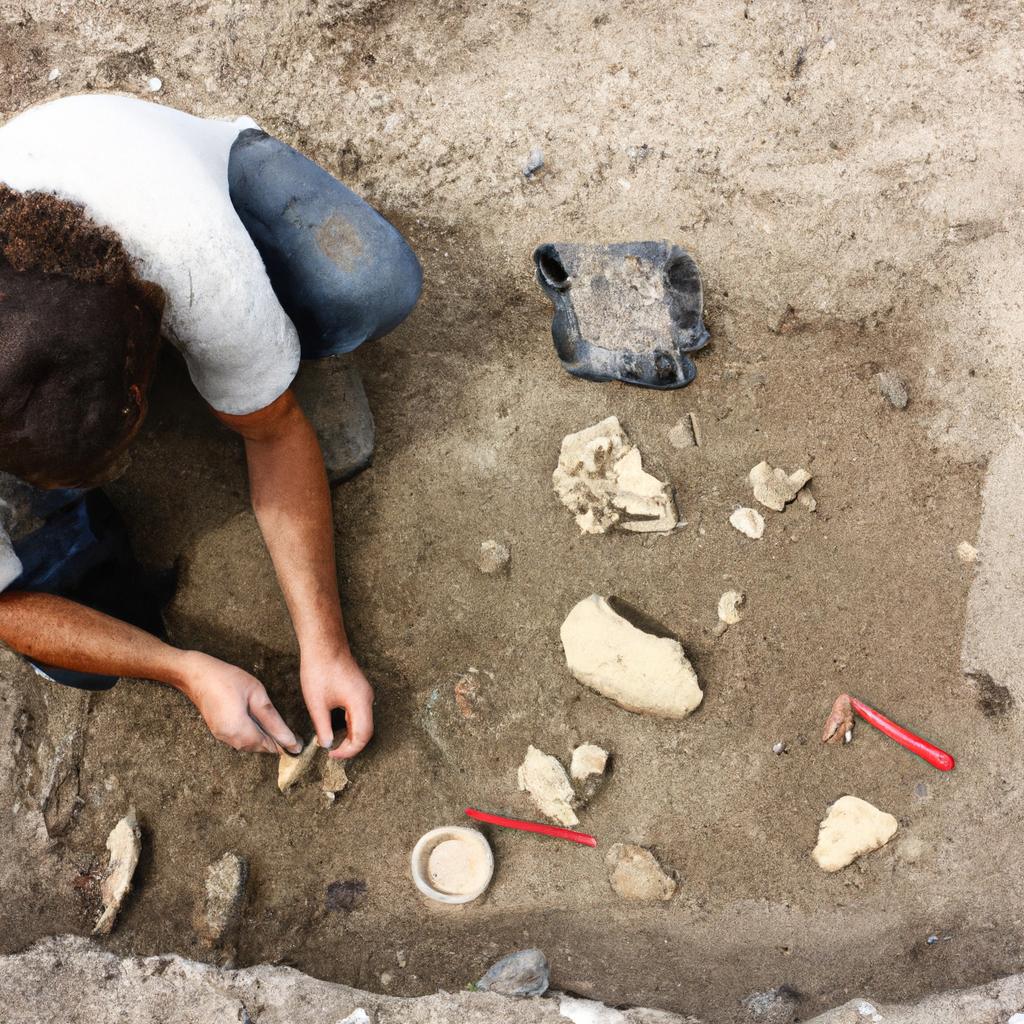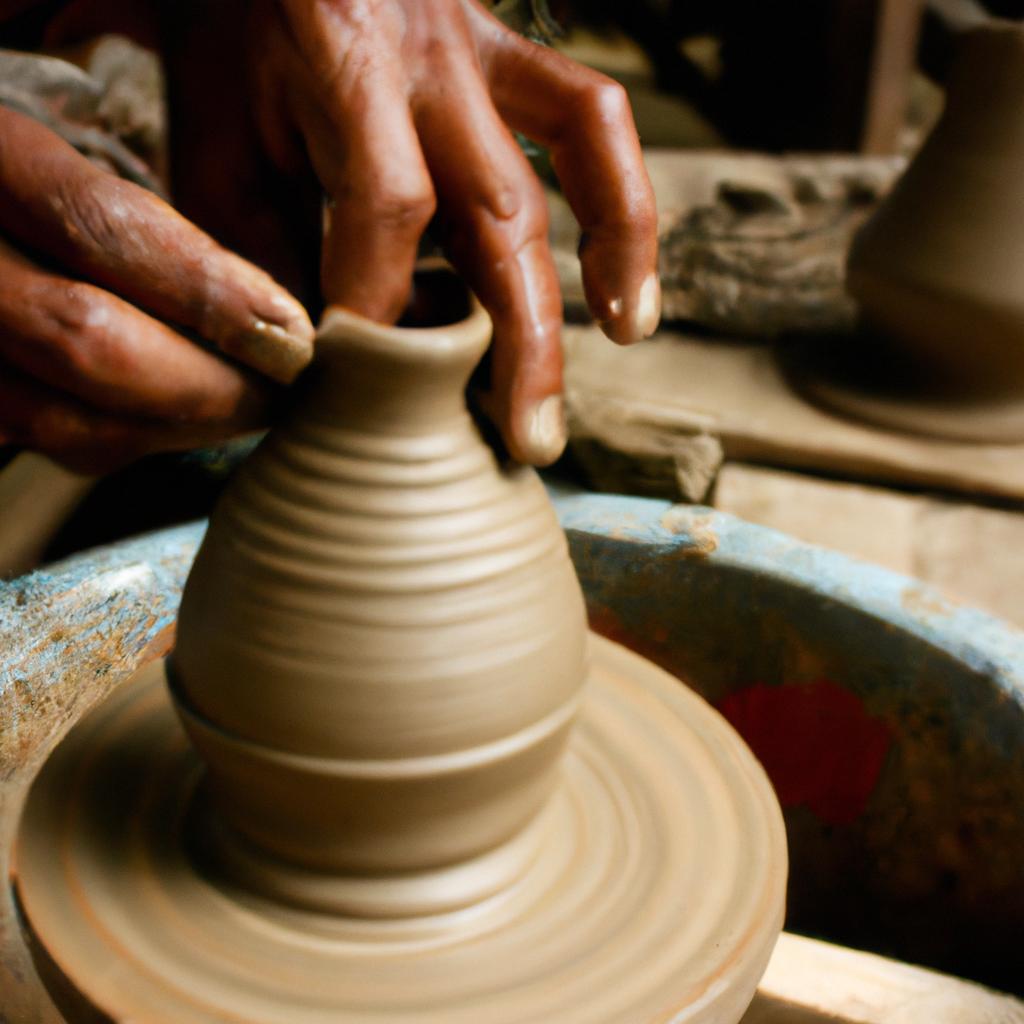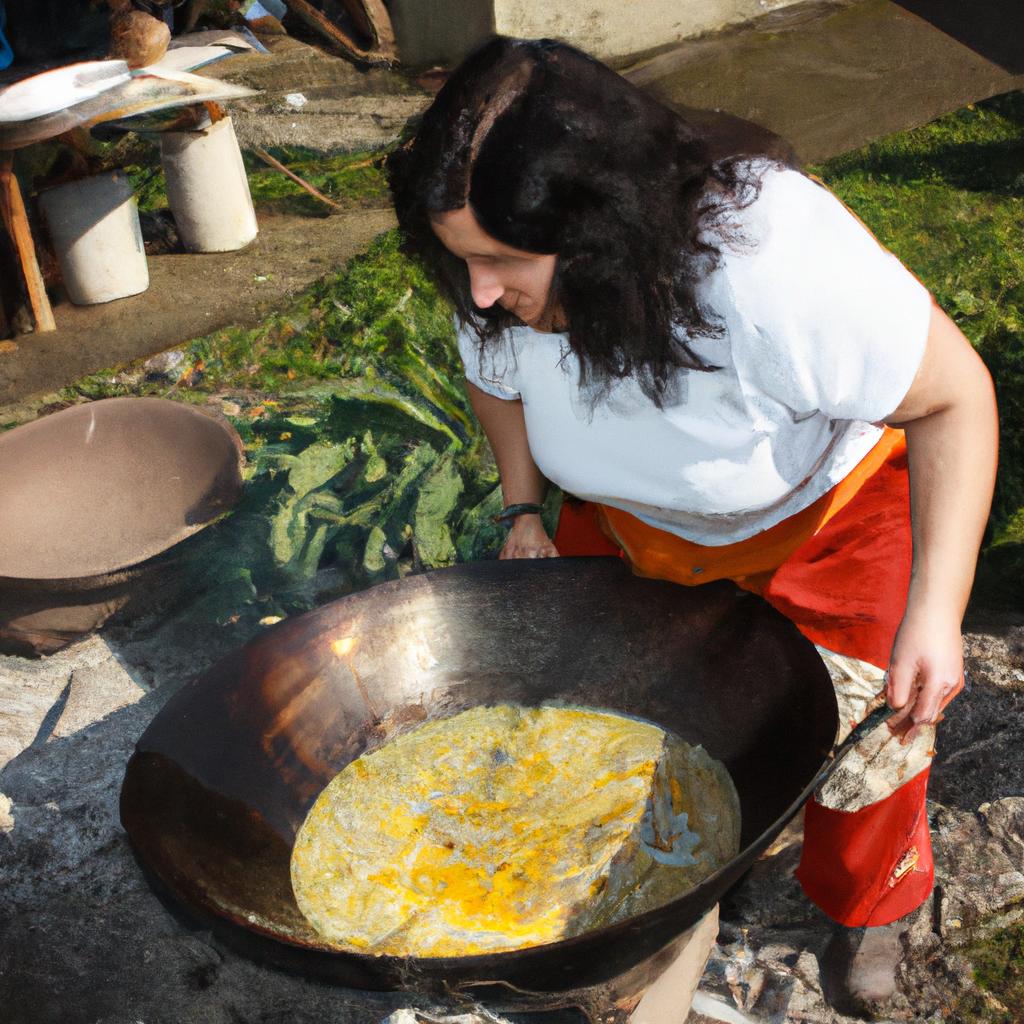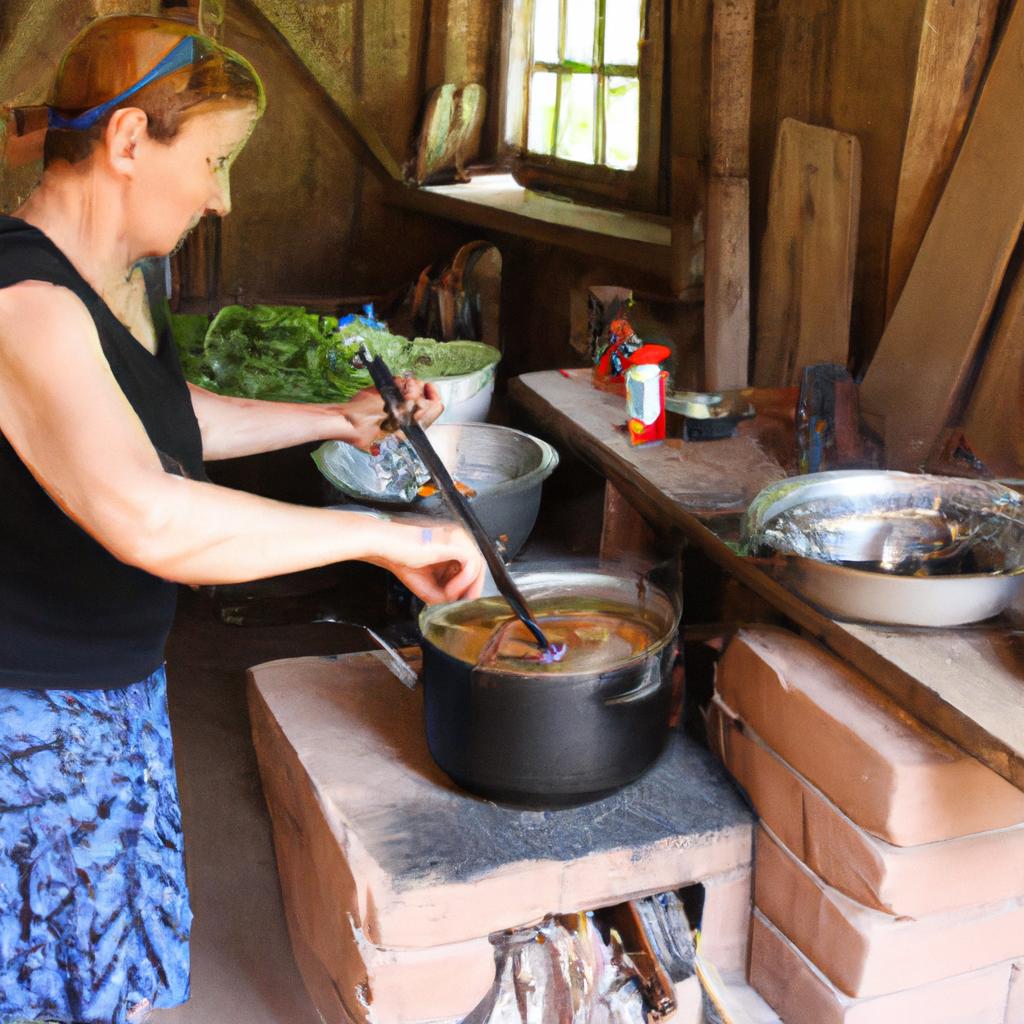Traditional music plays a significant role in enriching cultural experiences for tourists seeking rural accommodations. This article explores the impact of traditional music on cultural experiences in Cangas de Onas, a picturesque village nestled amidst the captivating landscapes of Spain’s Asturias region. By examining the interplay between traditional music and rural accommodation, this study aims to shed light on how such experiences contribute to promoting local heritage and attracting visitors.
To illustrate the importance of traditional music in enhancing cultural experiences, consider the case of Maria, an avid traveler who recently stayed at a rustic farmhouse in Cangas de Onas. Upon arrival, Maria was greeted by the melodious sounds of bagpipes resonating through the air as local musicians welcomed her with a heartfelt performance. Intrigued by this immersive musical experience, Maria delved deeper into understanding the historical and cultural significance behind these melodies, sparking her curiosity to explore more about the traditions and customs associated with traditional music in the area.
By immersing herself in Cangas de Onas’ rich musical heritage during her stay, Maria not only gained insights into local culture but also developed a deep appreciation for its preservation. Through participating in interactive workshops led by skilled musicians and attending lively folk festivals showcasing various genres of traditional music, she was able to witness firsthand the passion and dedication of the community in preserving their musical traditions.
Furthermore, Maria’s engagement with traditional music extended beyond her stay at the rural accommodation. She discovered that many local restaurants and cafes featured live performances by traditional musicians, creating an enchanting atmosphere that further enhanced her dining experiences. This integration of music into everyday life allowed Maria to connect with the local community on a deeper level and forge meaningful connections with both residents and fellow travelers.
The impact of traditional music on Maria’s cultural experience in Cangas de Onas was profound. Not only did it provide entertainment and enjoyment, but it also served as a gateway to understanding the history, values, and identity of the region. By immersing herself in these musical traditions, Maria gained a sense of belonging and appreciation for the rich heritage of Cangas de Onas.
Moreover, this case study highlights how traditional music can serve as a catalyst for attracting tourists to rural accommodations. The unique cultural experiences offered through music create a compelling allure for travelers seeking authentic encounters with local traditions. As word spreads about Cangas de Onas’ vibrant musical scene, more visitors are drawn to explore its picturesque landscapes while immersing themselves in its rich cultural tapestry.
In conclusion, traditional music plays a crucial role in enriching cultural experiences for tourists seeking rural accommodations. Through its ability to evoke emotions, foster connections, and promote local heritage, traditional music enhances the overall appeal of destinations like Cangas de Onas. By embracing their musical traditions and integrating them into tourism offerings, communities can attract visitors who seek authentic encounters and contribute to sustaining their cultural legacy for generations to come.
The Rich Heritage of Traditional Music in Cangas de Onas
The Rich Heritage of Traditional Music in Cangas de Onas
Traditional music holds a significant place in the cultural fabric of Cangas de Onas, a picturesque rural town nestled in the heart of Spain. From lively celebrations to intimate gatherings, music is woven into the daily lives of its residents, preserving age-old traditions and fostering community bonds. To truly appreciate the depth and richness of this musical heritage, it is important to delve into its historical roots, explore its various forms and styles, and understand its profound impact on local identity.
One remarkable example that exemplifies the importance of traditional music in Cangas de Onas is the annual Fiesta del Santo Patrono. This vibrant celebration brings together locals and visitors alike to honor their patron saint through song and dance. During this festival, musicians from different generations come together to perform stirring melodies on traditional instruments such as tambourines, bagpipes, flutes, and guitars. Their harmonious tunes fill the air with an undeniable energy that captivates all who witness it.
To evoke a sense of nostalgia for those who have experienced these enchanting musical moments or ignite curiosity among newcomers, we present four evocative elements:
- The captivating rhythms: The pulsating beats transport listeners into another world where time seems to slow down and emotions run high.
- The soul-stirring melodies: Melancholic yet uplifting tunes resonate deeply within one’s being, evoking memories and eliciting heartfelt responses.
- The joyous camaraderie: Inseparable from traditional music are the connections forged between performers and audience members – a shared experience that fosters unity.
- The oral tradition: Passed down through generations by word-of-mouth rather than written scores, these timeless songs transcend language barriers while keeping ancient customs alive.
Furthermore, understanding the diverse range of musical genres found in Cangas de Onas requires exploring its varied styles:
| Musical Genre | Description |
|---|---|
| Jota | A lively dance accompanied by castanets and tambourines, evoking a sense of festivity. |
| Alalá | Characterized by haunting melodies and poetic lyrics, this genre conveys deep emotions. |
| Muñeira | Known for its fast-paced rhythms and intricate footwork, it is often performed during celebratory occasions. |
In conclusion to this section, the traditional music in Cangas de Onas serves as not only an artistic expression but also as a vessel that carries the town’s history, culture, and collective memory. By exploring the historical roots of these musical traditions while appreciating their emotional impact on both performers and listeners, we can gain valuable insights into the unique identity of this rural community.
Moving forward with our exploration of traditional music in Cangas de Onas, we now delve into the local musical instruments used in performances as well as the distinct styles associated with each instrument.
Exploring Local Musical Instruments and Styles
The Rich Heritage of Traditional Music in Cangas de Onas offers a glimpse into the cultural experiences that can be explored through rural accommodation. Building upon this rich heritage, we now delve deeper into the local musical instruments and styles that contribute to the vibrant traditional music scene in this region.
To provide an example, let us consider the case of Marta, a traveler who recently stayed at a rural accommodation in Cangas de Onas. Upon arrival, she was immediately captivated by the melodious sounds floating through the air – a harmonious blend of bagpipes, tambourines, and flutes accompanied by passionate vocals. Intrigued by these enchanting tunes, Marta decided to embark on a journey to discover more about the local musical traditions.
Exploring Local Musical Instruments and Styles:
-
Bagpipes: One cannot mention traditional music in Cangas de Onas without acknowledging the central role played by bagpipes. These ancient instruments have been used for centuries as a means of storytelling and expression. The skill required to play them is awe-inspiring, with musicians adeptly manipulating the chanter and drones to create hauntingly beautiful melodies.
-
Tambourines: Another integral part of traditional music in this region are tambourines. These circular percussion instruments add rhythmic depth to performances, enhancing the overall experience for both performers and listeners alike. As Marta observed during her stay, they often accompany lively dances where locals showcase their agility and grace.
-
Flutes: Alongside bagpipes and tambourines, flutes also feature prominently in traditional music from Cangas de Onas. Crafted from wood or bone, these delicate instruments produce ethereal tones that transport listeners back in time. Skilled flute players effortlessly breathe life into ancestral melodies passed down through generations.
-
Vocal Traditions: In addition to instrumental prowess, vocal traditions form an essential component of traditional music here. Singers skillfully weave tales of love, loss, and triumph through their heartfelt performances. Marta was deeply moved by the emotional depth conveyed in each lyric, as she connected with the stories shared through this melodic medium.
Through the journey of exploration undertaken by individuals like Marta, traditional music in Cangas de Onas becomes a powerful vehicle for cultural immersion. As travelers engage with local musical instruments and styles, they gain a deeper understanding of the region’s heritage and its people’s way of life. This multifaceted experience fosters an appreciation for the rich tapestry of traditions that have shaped rural accommodation offerings in Cangas de Onas.
Transitioning into the subsequent section about “The Role of Traditional Music in Rural Accommodation,” one can see how these captivating musical experiences contribute to shaping guests’ overall perception and connection with their surroundings.
The Role of Traditional Music in Rural Accommodation
In the picturesque region of Cangas de Onas, traditional music is deeply ingrained in the local culture. As we delve deeper into our exploration of this fascinating topic, let us take a closer look at the diverse range of musical instruments and styles that are prevalent in this rural accommodation setting. To enhance our understanding, consider the case study of Marta, a visitor who found herself captivated by the traditional music scene during her stay.
One captivating aspect of traditional music in Cangas de Onas is the wide array of musical instruments used by local musicians. From the enchanting melodies produced by bagpipes to the rhythmic beats generated by tambourines, each instrument adds its unique flavor to the rich tapestry of sounds. For instance, Marta had the opportunity to witness a performance where a skilled musician effortlessly played multiple instruments simultaneously, creating an immersive sonic experience for all present.
As we explore further, it becomes evident that different styles of traditional music exist within Cangas de Onas. These various styles reflect not only regional differences but also historical influences. The hauntingly beautiful laments sung during religious processions evoke deep emotions among listeners and provide insight into centuries-old traditions. In contrast, lively jigs and reels performed during festive occasions showcase the joyful spirit and celebratory nature of the community.
- Immersion in authentic cultural experiences
- Connection with ancestral roots through shared musical heritage
- Appreciation for preservation efforts of intangible cultural heritage
- Sense of belonging fostered through participation in communal celebrations
Furthermore, exploring these aspects can be enhanced through reference to a table showcasing different musical instruments commonly encountered in Cangas de Onas:
| Instrument | Description | Significance |
|---|---|---|
| Bagpipes | Melodic wind instrument | Symbol of regional identity |
| Tambourine | Percussion instrument | Provides rhythmic accompaniment |
| Hurdy-gurdy | Stringed musical instrument | Creates unique, resonant melodies |
| Castanets | Hand-held percussion instruments | Adds lively beats to performances |
As we conclude this section on exploring local musical instruments and styles, it is crucial to note that traditional music in Cangas de Onas serves as a bridge between the past and the present. The preservation of these musical traditions not only enriches cultural experiences for visitors like Marta but also fosters a sense of community pride among locals. In our subsequent section about “Connecting with Local Musicians and Performances,” we will further delve into the opportunities available for visitors to engage directly with these talented performers.
Connecting with Local Musicians and Performances
Imagine a traveler arriving at a rural accommodation in Cangas de Onas, a picturesque village nestled in the scenic countryside of Spain. As they settle into their lodging, they are intrigued by the sounds of traditional music drifting from nearby venues and local gatherings. This encounter marks the beginning of an immersive cultural experience that offers insight into the significance and impact of traditional music within the community.
Traditional music plays a vital role in preserving and promoting cultural heritage, fostering connections between locals and visitors alike. By engaging with local musicians and attending performances, travelers have the opportunity to delve deeper into the rich traditions of Cangas de Onas. For instance, let’s consider Maria, a tourist who attends a lively folk concert during her stay. She not only enjoys the musical performance but also gains awareness about historical events celebrated through these songs—such as tales of bravery during battles or expressions of love for one’s homeland.
To better understand how traditional music enhances cultural experiences in this region, we can explore its various dimensions:
- Emotional resonance: The melodies and rhythms evoke powerful emotions, transporting listeners to different times and places.
- Community cohesion: Traditional music serves as a unifying force among residents, reinforcing social bonds and fostering collective identity.
- Intergenerational transmission: Through participation in musical activities, younger generations learn from older ones, ensuring continuity and preservation of customs.
- Enhanced tourism appeal: The integration of traditional music within rural accommodations adds value to tourists’ experiences while contributing to sustainable development.
By examining these aspects, it becomes evident that traditional music is deeply ingrained in the fabric of Cangas de Onas’ culture. Its ability to stir emotions, build community ties across generations, and enhance tourism offer compelling reasons to further explore its importance within this context.
As we continue our exploration into preserving and promoting traditional music in Cangas de Onas, we will delve into the initiatives undertaken by local organizations and stakeholders to ensure its continued vitality in the community. From music festivals celebrating regional talent to educational programs introducing younger generations to traditional instruments, these efforts actively contribute to fostering a dynamic environment where cultural traditions thrive. Let us now turn our attention to these endeavors that shape and sustain Cangas de Onas’ musical heritage for future generations.
[Transition Sentence into the subsequent section about “Preserving and Promoting Traditional Music in Cangas de Onas.”]Preserving and Promoting Traditional Music in Cangas de Onas
Building upon the connections made with local musicians, staying in rural accommodations in Cangas de Onas offers a unique opportunity to actively participate in preserving and promoting traditional music. By engaging with the community’s rich musical heritage, visitors can immerse themselves in an authentic cultural experience that transcends mere observation.
Preserving and Promoting Traditional Music in Cangas de Onas:
One notable way of preserving traditional music is through organized workshops offered by local musicians. These workshops provide participants with hands-on experiences where they can learn about different instruments, such as the gaita asturiana (Asturian bagpipe) or tamboril (small drum), while also gaining insights into regional musical techniques and styles. For instance, attendees may have the chance to compose their own melodies inspired by traditional Asturian folk songs under the guidance of experienced musicians. Such interactive sessions not only foster appreciation for traditional music but also encourage active engagement from both locals and tourists alike.
To further showcase the significance of traditional music, periodic concerts are arranged at various venues within Cangas de Onas. These performances feature talented musicians who skillfully blend age-old traditions with contemporary influences, resulting in captivating musical renditions. Attendees can witness firsthand how these artists skillfully play instruments like guitars, fiddles, accordions, and flutes – all central to traditional Asturian music. The harmonious melodies resonate throughout the audience, creating a sense of unity among those present and fostering a deeper connection between performers and listeners.
In addition to workshops and concerts, local organizations collaborate to organize festivals dedicated solely to celebrating traditional music. These events attract enthusiastic crowds from near and far who gather together to revel in the joyous sounds of lively jotas (folk dances) and vibrant melodies. The festive atmosphere, filled with laughter, dancing, and shared cultural experiences, encapsulates the essence of traditional music’s role in community bonding and pride.
- Engaging with traditional music promotes intercultural understanding and appreciation.
- Participating in workshops nurtures creativity while preserving musical traditions.
- Concerts provide a platform for talented musicians to showcase their skills.
- Festivals create an inclusive environment where people can connect through music.
Emotional Table:
| Benefits of Traditional Music | |
|---|---|
| Preserves cultural heritage | Fosters sense of identity |
| Encourages community engagement | Promotes social cohesion |
| Enhances tourism appeal | Inspires artistic expression |
By actively participating in the preservation and promotion of traditional music, visitors not only gain valuable insights into local culture but also enhance their overall tourist experience. In the subsequent section, we will explore how incorporating traditional music enriches various aspects of a trip to Cangas de Onas.
Enhancing Tourist Experiences through Traditional Music
Exploring Cultural Experiences in Cangas de Onas
Preserving and promoting traditional music in rural accommodation establishments is crucial for enhancing cultural experiences in Cangas de Onas. By immersing tourists in the rich musical heritage of the region, these accommodations not only contribute to the preservation of local traditions but also provide visitors with unique and memorable experiences.
One example that illustrates the impact of incorporating traditional music into rural accommodations is Casa Rural la Rondina. Located amidst picturesque landscapes, this charming guesthouse offers guests an immersive experience by organizing live performances featuring local musicians playing traditional instruments such as bagpipes and tambourines. These musical evenings create a vibrant atmosphere where guests can actively engage with the cultural identity of Cangas de Onas.
To further enhance tourist experiences through traditional music, rural accommodations can consider implementing the following strategies:
- Collaborating with local musicians: Establishing partnerships with talented musicians from the community allows rural accommodations to offer authentic performances that showcase the true essence of traditional music.
- Providing interactive workshops: Organizing hands-on workshops on traditional instrument playing or folk dances enables guests to actively participate and learn about local music traditions.
- Incorporating themed events: Hosting special events centered around specific themes like Galician folklore or Asturian ballads adds variety to guests’ stay while deepening their understanding of regional culture.
- Curating informative materials: Offering brochures, guidebooks, or digital resources that detail the history and significance of different types of traditional music helps foster a deeper appreciation among visitors.
Through these initiatives, rural accommodations become more than just places to stay; they transform into gateways for cultural exploration. To illustrate these ideas visually, we present a table showcasing potential activities at Casa Rural la Rondina:
| Activity | Description | Benefits |
|---|---|---|
| Live Performances | Regular concerts by local musicians | Immersive cultural experiences |
| Instrument Workshops | Hands-on sessions on traditional instrument playing | Active participation and learning |
| Themed Events | Special events highlighting specific aspects of regional music | Enhanced understanding of local culture |
| Information Materials | Brochures or digital resources providing information on the history and significance | Deeper appreciation for different types of traditional music |
By incorporating these strategies, rural accommodations can create a welcoming environment that not only preserves and promotes traditional music but also fosters meaningful connections between guests and Cangas de Onas’ vibrant cultural heritage. Such initiatives contribute to enriching tourist experiences by offering an immersive exploration of the region’s unique musical traditions.
 Casa Amparo Triana
Casa Amparo Triana



